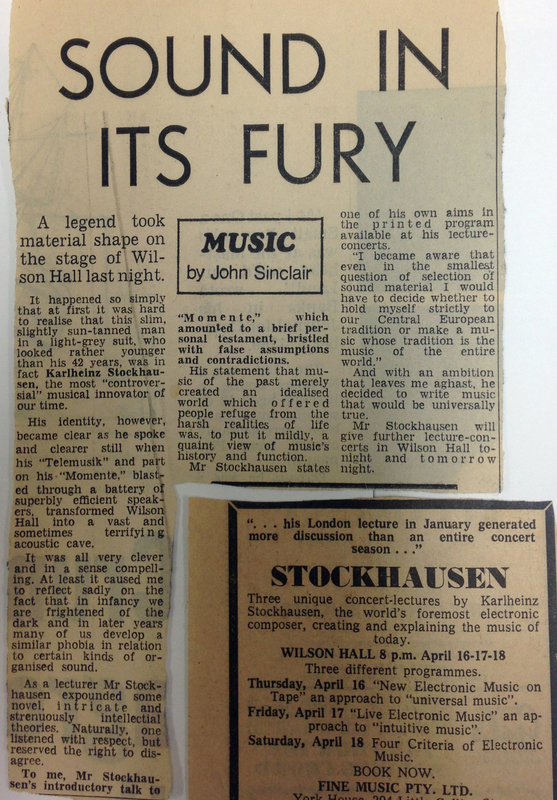John Sinclair, Sound in its fury, Melbourne Herald, and two unidentified newspaper clippings, 1970
Dublin Core
Title
John Sinclair, Sound in its fury, Melbourne Herald, and two unidentified newspaper clippings, 1970
Subject
Description
John Sinclair, Sound in its fury, Melbourne Herald, and two unidentified newspaper clippings, 1970
German composer Karlheinz Stockhausen (1928–2007), described as the ‘most controversial musical innovator of our time’, has influenced many musicians, inside and outside of the avant-garde music scene. Rock musicians including Frank Zappa, Peter Townshend, Jerry Garcia and Björk, and Jazz musicians including Miles Davis, George Russell, Anthony Braxton and Charles Mingus, all name Stockhausen as a major influence. The Beatles included a portrait of Stockhausen on the front cover of their album, Sgt. Pepper’s Lonely Hearts Club Band, in 1967.
Stockhausen visited Australia for ten days in April 1970. He gave concert-lectures on electronic music around the country, including three programs in Wilson Hall, at the University of Melbourne. Delivered through a battery of speakers, Stockhausen’s electronic music ‘transformed Wilson Hall into a vast and sometimes terrifying acoustic cave’. The Grainger Centre electronic music enthusiasts, including Keith Humble, Ian Bonighton and Agnes Dodds, helped set up Wilson Hall with the electronic equipment. Stockhausen was apparently very demanding, and Wilson Hall was not the ideal venue, with not enough powerpoints for all of the equipment.
For the first composers of electronic music, there was a tension between the creation of new sounds never heard before in a musical context, and the necessity to represent these in a way that future musicians could interpret for performance or study. Graphic scores, such as Stockhausen’s Kontakte are examples of the creative solutions that composers invented for this purpose.
Traditional notation systems were replaced by graphic elements, such as undulating lines or circling points, shapes such as squares and rectangles filled with tone, or even colour. Graphic scores were also useful for representing ‘chance’ music, overcoming of the concept of duration by leaving the ordering of different passages indeterminate. American composer Morton Feldman, who spent most of his career trying to erase any sense of metre from his music, used graphic scores in order to make time “less perceptible as movement, more conceivable as image”.
German composer Karlheinz Stockhausen (1928–2007), described as the ‘most controversial musical innovator of our time’, has influenced many musicians, inside and outside of the avant-garde music scene. Rock musicians including Frank Zappa, Peter Townshend, Jerry Garcia and Björk, and Jazz musicians including Miles Davis, George Russell, Anthony Braxton and Charles Mingus, all name Stockhausen as a major influence. The Beatles included a portrait of Stockhausen on the front cover of their album, Sgt. Pepper’s Lonely Hearts Club Band, in 1967.
Stockhausen visited Australia for ten days in April 1970. He gave concert-lectures on electronic music around the country, including three programs in Wilson Hall, at the University of Melbourne. Delivered through a battery of speakers, Stockhausen’s electronic music ‘transformed Wilson Hall into a vast and sometimes terrifying acoustic cave’. The Grainger Centre electronic music enthusiasts, including Keith Humble, Ian Bonighton and Agnes Dodds, helped set up Wilson Hall with the electronic equipment. Stockhausen was apparently very demanding, and Wilson Hall was not the ideal venue, with not enough powerpoints for all of the equipment.
For the first composers of electronic music, there was a tension between the creation of new sounds never heard before in a musical context, and the necessity to represent these in a way that future musicians could interpret for performance or study. Graphic scores, such as Stockhausen’s Kontakte are examples of the creative solutions that composers invented for this purpose.
Traditional notation systems were replaced by graphic elements, such as undulating lines or circling points, shapes such as squares and rectangles filled with tone, or even colour. Graphic scores were also useful for representing ‘chance’ music, overcoming of the concept of duration by leaving the ordering of different passages indeterminate. American composer Morton Feldman, who spent most of his career trying to erase any sense of metre from his music, used graphic scores in order to make time “less perceptible as movement, more conceivable as image”.
Creator
Format
newspaper clippings
Identifier
Grainger Museum Archive, 2017/23-9/8


